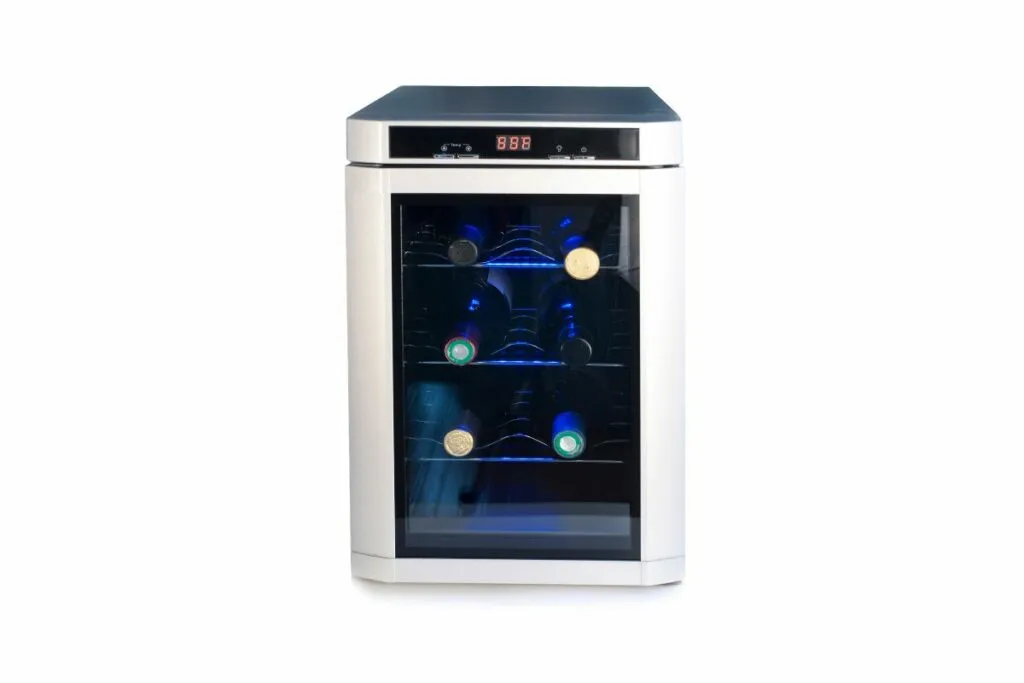As an Amazon Associate, I earn from qualifying purchases with no additional costs for you.
In recent years, Freon has been a hot-button topic when it comes to wine storage in wine refrigerators and how they cool. A typical wine refrigerator looks and works much like a smaller version of a kitchen refrigerator.
It has a compressor that pressurizes a refrigerant that, in turn, fluxes between liquid and vaporous states to produce a cooling effect that is refrigeration. For decades, the most widely used refrigerant and the one that has been most commonly associated with cooling and refrigeration systems are known as Freon.
Do wine refrigerators have Freon? Older compressor wine refrigerators built before 2010 will likely use Freon in their cooling systems, while compressor coolers that were built after 2010 will not have Freon due to environmental concerns. Alternative refrigerants have been used since that time, and environmentally friendly, refrigerant-free thermoelectric models have become increasingly popular.
As we will discuss in this article, global industries have heavily relied upon Freon and similar chemicals to power air conditioners in our homes, cars, and offices and refrigeration systems for our kitchens and production facilities.
However, these uses have been steadily phased out as part of a worldwide effort to curtail global warming and climate change and to halt the depletion of the ozone layer.

TIP: If you want to check out the best refrigerator for wine storage, I recommend trying out the Avation (18 bottles) compressor refrigerator with Wi-fi smart app control cooling system. You can find this refrigerator by clicking here (Amazon link).
What is Freon?
Freon is a refrigerant that also goes by the technical names R-22 and HCFC-22. A refrigerant is a fluid that fluxes back and forth between gaseous and liquid phases in a process that produces chilled air.
In this particular application, Freon has become synonymous with air conditioning and refrigeration for many years.
What are HCFCs?
Freon is what is known as a hydrochlorofluorocarbon, or HCFC for short. An HCFC is a compound of gases containing hydrogen, chlorine, fluorine, and carbon. It is chemically similar to another banned substance, chlorofluorocarbon (CFC), which has also been identified as extremely harmful to the ozone layer and as a major contributor to global warming and climate change.
The production and use worldwide of both CFCs and HCFCs have been drastically reduced via protocols, measures, and regulations in the United States, throughout the European Union, and by a host of other nations.
The EPA & Clean Air Act: Impacts on Freons in Wine Coolers

In 1963 the United States Congress passed the Clean Air Act recognizing the urgent need to fund studies about the dangerous effects of air pollution.
Significant amendments were made in 1970 to strengthen the law and to implement measures to reduce air pollution. That same year, the United States Environmental Protection Agency (EPA) was created by Congress.
The discovery of a “hole” in the ozone layer over the South Pole prompted a global outcry for immediate and lasting action as it became increasingly clear that emissions of certain chemicals, namely HCFCs, CFCs, and other synthetic substances, were destroying the stratospheric ozone that is responsible for protecting the planet from our sun’s damaging ultraviolet (UV) rays.
In 1987 a collaborative global effort to reduce the harmful effects of HCFCs and other chemicals on stratospheric ozone known as the Montreal Protocol on Substances that Deplete the Ozone Layer (source) was enacted with the United States joining in the effort to identify and then eliminate substances known to irreversibly damage the environment.
TIP: If you would like to help to protect the environment by recycling wine bottles and corks, read this article. Are plastic wine bottles environmentally friendly? Read this article to find out.
Are Any Freon Products Banned?

In 1990 another significant amendment to the Clean Air Act specifically addressed growing concerns regarding global warming and the depletion of the ozone layer.
Among the measures implemented by this amendment and the Montreal Protocol was phasing out the manufacture, importation, and use of certain chemicals and substances.
Were any Freon products among the chemicals sought to be banned? Yes, the 1987 Montreal Protocol and the 1990 amendment to the Clean Air Act initiated the structured phasing out of all hydrochlorofluorocarbons, including HCFC-22, commonly known as Freon. The EPA was empowered by Congress to enforce these provisions, and companies and industries were forced to comply.
Because the use of Freon and other HCFCs was so extensive and far-reaching across so many industries in the 1990s and early 2000s, an outright and immediate ban was not feasible.
Steps were enacted to systematically reduce overall reliance on HCFCs and to afford sufficient time to develop viable substitutes for Freon and other refrigerants.
There were four specific dates laid out in the phasing-out plan (source) with correlating actions thereto:
- January 1, 2010 – the production, import and use of HCFC-22 (Freon) and other HCFCs are banned (except servicing existing equipment using these substances)
- January 1, 2015 – the production, import and use of all HCFCs are banned (except servicing existing refrigeration equipment, i.e., those already in service and using Freon)
- January 1, 2020 – all production and import of HCFCs (including Freon) is banned; after 2020 the only type of service involving Freon that will be allowable is that which uses recycled or previously stockpiled Freon
- January 1, 2030 – the production and import of any remaining HCFCs is banned
It should be noted that Freon is itself not illegal. The use of Freon in existing cooling and refrigeration systems is permissible even today so long as the Freon has been recycled from previous use or comes from an existing stockpile.
It does appear that by January 1, 2030, however, that any use of Freon or other HCFCs will be banned outright.
Since the production, import, and use of Freon have been banned effective January 1, 2010, any refrigeration systems, including compressor wine fridges manufactured since that date, have utilized different types of refrigerants that do not fall under the restrictions of the Montreal Protocol or the 1990 Amendment to the Clean Air Act.
TIP: Should you put a wine fridge next to the oven, and are they really expensive to run? We answer these important questions in this article and this one.
Recommendation box: Everything you need to enjoy your wine as much as possible. All recommended products are personally tested and regularly used by experts from this website (Amazon links):
> Ivation Wine Cooler – Energy-efficient wine cooler for 18 bottles with Wi-fi smart app control cooling system.
> Wine Rack – Beautiful, elegant wood rack for up to 7 bottles and the choice of vertical or horizontal storage.
> Durand Wine Opener – Classic vintage wine opener (we like all these classic staff).
> YouYah Iceberg Wine Decanter – The most beautiful and handy wine decanter we personally use.
> Bormioli Rocco Wine Glasses – A set of eight elegant and traditional wine glasses made in Italy.
> Vintorio Wine Aerator – Simple but really useful wine aerator for a reasonable price.
> The Original Vacu Vin Wine Saver – The best wine saver on the market in a package with two vacuum stoppers and two wine servers.
And if you want to become a true connoisseur of wine, we recommend reading the book Wine Folly: The Essential Guide to Wine (Amazon link), where you will find all the information you need about winemaking, wine varieties, flavors, and much more.
What Refrigerants Do Wine Fridges Use

Two post-Freon refrigerants are commonly used in compressor wine fridges, and both are considered ozone-friendly.
R-410A
This is perhaps the most commonly used alternative to Freon or R-22. R-410A is a hydrofluorocarbon (HFC), and as the name suggests, it lacks chlorine, which is suspected of being the primary agent responsible for environmental harm.
Trade names for this refrigerant include Puron, Gentron AZ-20, and SUVA 410A. The most common applications for R-410A are residential and commercial air conditioning units.
It is also used in industrial refrigeration applications but seemingly not smaller units. This is likely because R-410A is a blend of two refrigerants and, as a result, requires a higher pressure for it to be effective, which would necessitate larger components with sturdier construction.
R600a
This refrigerant is an isomer of butane (isobutane), meaning that it shares the same chemical formula as butane but has a different molecular structure.
Due to its high thermodynamic attributes and very low environmental impact, this is quickly becoming the refrigerant of choice for domestic-use refrigerators, including wine fridges. R600a also goes by the trade name Care 10.
There is one major caveat that comes with R600a. Unlike R-410A, this refrigerant is highly flammable and potentially explosive. For this reason, consideration must be given as to where a wine fridge using this refrigerant is placed in the home, i.e., away from any direct heat source or open flame.
Although the chances of a refrigerant leak are remote and would likely only occur in the event of a rupture in the refrigerant line, it is nevertheless a circumstance that cannot be ignored, and appropriate steps should be taken to ensure a safe installation of the wine fridge.
TIP: Does all wine have to be stored in cooler temperatures, and is a refrigerator really necessary? Find out here. Can unopened wine go bad? Read this article to find out.
Thermoelectric Wine Fridges

It is also worth noting that thermoelectric wine fridges do not use any refrigerant at all because they do not rely on a compressor but rather one or more Peltier devices to cool the air inside the compartment.
Thermoelectric models are becoming increasingly popular as environmentally-friendly home wine storage options.
Whether you decide to go with a thermoelectric wine fridge or a more robust compressor model, you can enjoy some peace of mind as you sip your perfectly chilled wine that today’s wine fridges are as environmentally friendly as they have ever been and all indications are that this trend will continue.
TIP: Check out this page for a complete list of wine products and accessories I love. You’ll find my recommendations for wine refrigerators, decanters, and aerators and the best place to buy wine online. Click here to see the complete listing.
